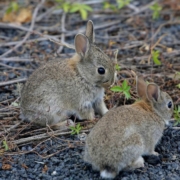Lanzarote’s rabbits are not easy to spot, but they have given the islanders a nickname and provided a living for generations, while causing headaches for farmers.
In the Canaries, each group of islanders have their own nickname. Gran Canarians are, rather unoriginally, called canarios; while those from Tenerife are named chicharerros after the cheap mackerel they used to eat.
On Lanzarote, the name for islanders is conejeros, which means rabbit hunters. The nickname derives from a time when one of the main exports of the island was rabbit skins, and there were so many rabbits on the island that this became an important trade.
There are no rabbit skins without rabbits, and bunnies have only existed on the Canaries islands for a little over 500 years. It is generally believed that they were brought over by the conquistadores of the islands for food, either being freed or escaping to form large native populations.
Rabbit still remains popular at the Canarian dining table, and the recipe for Conejo al Salmorejo (rabbit in a herby wine sauce) is a local favourite, although it’s usually captive rabbits that are used for food.
Wild rabbits exist on all the Canary Islands, including the smaller isles of Lobos and La Graciosa. However, although they may be cute, they remain classified as an invasive species despite having existed here for over half a millennium.
That’s because rabbits have changed the landscape of the islands drastically. Their voracious appetites and prolific breeding have long posed a threat to various species of plants and, along with goats, they are one of the introduced species that most contributes to soil erosion and the resulting desertification.
They do this by simply nibbling away at younger plants, meaning they do not develop enough to be able to form root systems that bind the soil. Instead, it becomes loose and is blown away in dry, windy weather.
That’s why biodiversity groups have usually supported not just the culling, but the eradication of rabbit populations on the Canaries.
Now that there is no trade in rabbit skins or meat, it is ironic that one of the main groups supporting the existence of rabbits is rabbit hunters, who are permitted to hunt rabbits between the months of August and October using dogs or ferrets.
Canarian hunters’ associations have campaigned to have rabbits removed from the list of invasive species, and have generally been far more active in the protection of rabbit populations than public authorities.
The hunting lobby has also alerted authorities to the existence of diseases among the local rabbit population, and has proposed protective measures such as releasing rabbits that have been vaccinated against illnesses such as myxomatosis.
Otherwise, rabbits have few natural predators on the island. Some are killed by feral cats and dogs, and birds such as ravens and owls may account for a handful, but the creatures generally live a fairly undisturbed life.
That’s helped by the fact that rabbits tend to keep away from human beings on Lanzarote. Some residents have lived here for years without ever seeing a rabbit, and they’re very rarely found near centres of population.
Rabbits are most often seen early in the morning or night, in rural areas of the island. The grey/brown colour makes them even better camouflaged against the local terrain than they are on green fields, and if you do see one it is likely to give itself away by the movement of its fluffy tail.











Leave a Reply
Want to join the discussion?Feel free to contribute!